CHESS
For the record
Raymond Keene
LAST WEEK I promised a full review of Jon Speelman's new book, Jon Speelman's Best Games (Batsford, £15.99). The book contains 38 of the grandmaster's most impressive games, with characteristically profound annotations. Speelman stands as a superb symbol of the renaissance of British chess which occurred during the 1980s. In the previous decade, England finally obtained some grandmasters (the first two were Tony Miles and myself), and our performances in the biennial chess Olympiad started to look impressive. Still, having spent around half a century in the chess wilderness, there was no way in which England could then have been described as a global chess power.
During the 1980s, all of this changed. It started with three consecutive silver medals in the chess Olympiads, while in 1988 Speelman began a campaign which brought him to the semi-final of the world champi- onship qualifying tournament. His victims include Garry Kasparov, Anatoly Karpov and Nigel Short, who went on to challenge for the world title itself in 1993.
In order to progress in the world cycle Speelman had to defeat Short in the quar- ter-final of the qualifying competition. This episode in his career is dealt with by Speelman in the book in immense detail. Indeed, a theme of the volume is his record against his English colleagues. One might have expected to see the aforementioned victories against the champions, such as Kasparov and Karpov. Instead, Speelman's move-by-move dissection of the battle against Short and wins against other such luminaries as Tony Miles, John Nunn and Murray Chandler casts a brilliant search- light on a historic moment when England was leaping to world prominence. Speelman—Azmaiparashvili: Spanish Team Championship 1994; Irregular Opening.
1 d4 d6 2 e4 Nf6 3 f3 e6 The situation is now utterly unorthodox, hence entirely to Speelman's taste. By playing 3 ... g6 Black could, of course, simply transpose to a main line of the King's Indian Defence. 4 Be3 Bel 5 c4 5 0-0 6 Nc3 c5 7 d5 a6 8 a4 b6 9 Bd3 Bbl Provocation! The bish- op is biting on granite here. According to Speelman 9 ...Ra7 was normal. 10 Nh3 10 Nge2 was a very playable alternative. 10 ...e5 Since the white centre is very well defended, it makes some sense to block and then try to percolate round the edges. But of course White has a pleasant advantage. 11 g3 If 11 Nf2 Black can play to control the dark squares with 11 ... Nh5 and if 12 g3 Bg5!; or 12 Qd2 Nf4 causes trouble. 11 ...Nh5 12 f4 exf4 13 gxf4 g6 14 Rgl This looks very appealing; but the knight on g7 will be an excellent defender. 14 ...Ng7 15 Ng5 Bxg5 16 Rxg5 f6 17 Rgl f5 18 Qf3 fxe4 19 Nxe4 Nd7 20 Bc2 Qh4+ Despite his rather dubious opening play, Black has seized the initiative. Neverthe- less, 20 ...Nf6 or even 20 ... Nf5 would both have been improvements over the text which is much too adventurous. 21 Bf2 Qe7 22 0-0-0 Ne5 23 Qe2 Rxf4 24 Bg3 Nh5 (Diagram) This disas- trous misjudgment follows from Black's previous moves, after which White appeared to be on the run. Nevertheless, White now turns the tables with a queen sacrifice (Speelman, as readers of his book will discover, loves sacrificing his queen). Correct would have been 24 ... Raf8! when Black would have had reasonable compen- sation for the exchange. 25 QxhS This queen sac- rifice turns the game around. White develops a
ferocious initiative. 25 gxh5 If 25 Rxe4 26 Bxe4 gxh5 27 Bxe5 + Kf8 28 Rdfl + Ke8 29 Rg8+ Kd7 30 Bf5+ Kc7 31 Rg7 wins. 26 Bxf4+ Ng6 27 Bg5 Qe5 28 Nf6+ Kh8 29 Bxg6 29 Nxh7 Kxh7 30 Bxg6+ is also sufficient. But once Speelman had worked out this infinitely more aesthetic route, he could not possibly resist it. 29 hxg6 30 Rdel Qxh2 He might as well. If 30
Qd4 31 Re7! Qxc4+ (31 ... Qxgl+ is the same as in the game, but with White's h-pawn still alive) 32 Kbl Qd3+ 33 Kal escapes the checks immediately. 31 Re7 Qxgl+ 32 Kc2 Qf2+ 33 Kb3 Qt3+ 34 Ka2 (Diagram) Black has
run out of checks and must now return the queen, after which White simply emerges a piece up thanks to the dual threats along the seventh rank. 34 ... Qxf6 35 Bxf6+ Kg8 36 Rxb7 b5 37 Rg7+ Kf8 38 Rh7 bxa4 39 Bc3 Of course, 39 Rh8+ Kf7 40 Rxa8 Kxf6 is also an easy win. But this is even cleaner. 39 ...Re8 40 Rh8+ Kf7 41 Rxe8 Kxe8 42 Bf6 Black resigns.


















































































 Previous page
Previous page